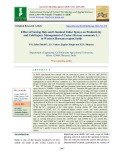
Int.J.Curr.Microbiol.App.Sci (2018) 7(11): 2447-2454
2447
Original Research Article https://doi.org/10.20546/ijcmas.2018.711.279
Effect of Sowing Date and Chemical Foliar Sprays on Productivity
and Cold Injury Management of Castor (Ricinus communis L.)
in Western Haryana region, India
P.S. John Daniel*, J.S. Yadav, Jagdev Singh and K.D. Sharma
Department of Agronomy, CCS Haryana Agricultural University,
Hisar-125004, Haryana, India
*Corresponding author
A B S T R A C T
Introduction
India is one of the largest producers of non-
edible oil seeds in the world. Castor is an
important non-edible oil seed crop of India
playing a pivotal role in the agrarian economy.
The oil extracted from the castor already has a
demonstrated market, guaranteed by variety of
International Journal of Current Microbiology and Applied Sciences
ISSN: 2319-7706 Volume 7 Number 11 (2018)
Journal homepage: http://www.ijcmas.com
A field experiment was carried out in consecutive years of 2013-14 and 2014-15
conducted at regional research station, Bawal, CCS Haryana Agricultural University to
study effect of sowing time and chemical foliar sprays on the productivity and cold injury
management in castor (Ricinus communis L.). The experiment was laid out in split plot
design on loamy sand soil. Treatments comprised of four dates of sowing viz., 20th June,
5th July, 20th July and 5th August and four chemical foliar sprays along with water and no
spray check viz., DMSO (78 ml ha-1), H2SO4 (0.1%), Thiourea 500 ppm, Salicylic acid 100
ppm that are replicated thrice. Among the different dates of sowing, 20th June resulted in
significantly higher growth and yield parameters during 2013-14 and 2014-15 crop seasons
compared to other dates of sowing. 20th June date of sowing produced significantly higher
grain yield i.e., 5157 kg ha-1 during 2013-14 and 5412 kg ha-1 during 2014-15 as well
pooled grain yield 5285 kg ha-1 as compared to the 20th July and 5th August sowing dates.
Application of H2SO4 (0.1 %) showed significantly substantial effect on grain yield (4703
kg ha-1) during 2013-14 and during 2014-15 (4869 kg ha-1) as well as on pooled basis
(4786 kg ha-1) compared to the foliar sprays. Sowing during 20th June along with
application of H2SO4 (0.1 %) registered higher relative water, leaf water potential,
chlorophyll index and lower membrane injury as compared to different sowing dates and
chemical foliar sprays during 2013-14 and 2014-15 crop seasons. In economic analysis of
two year data, profitability of castor in terms of returns was substantially high in 20th June
date of sowing with gross returns (Rs. 203702 ha-1 and 216480 ha-1), net returns (Rs.
150622 ha-1 and 163809 ha-1) and B:C ratio (3.84 and 4.11) as compared to other sowing
dates. Among the chemical foliar sprays, H2SO4 (0.1 %) significantly recorded higher
gross returns (Rs. 185769 ha-1 and Rs. 196080 ha-1), net returns (Rs. 130759 ha-1 and Rs.
141479 ha-1) and B: C ratio (3.39 and 3.59, respectively) when compared to other foliar
sprays.
Keywords
Castor, DCH-177,
Foliar sprays, Cold
injury, Economics,
B: C ratio
Accepted:
18 October 2018
Available Online:
10 November 2018
Article Info





















